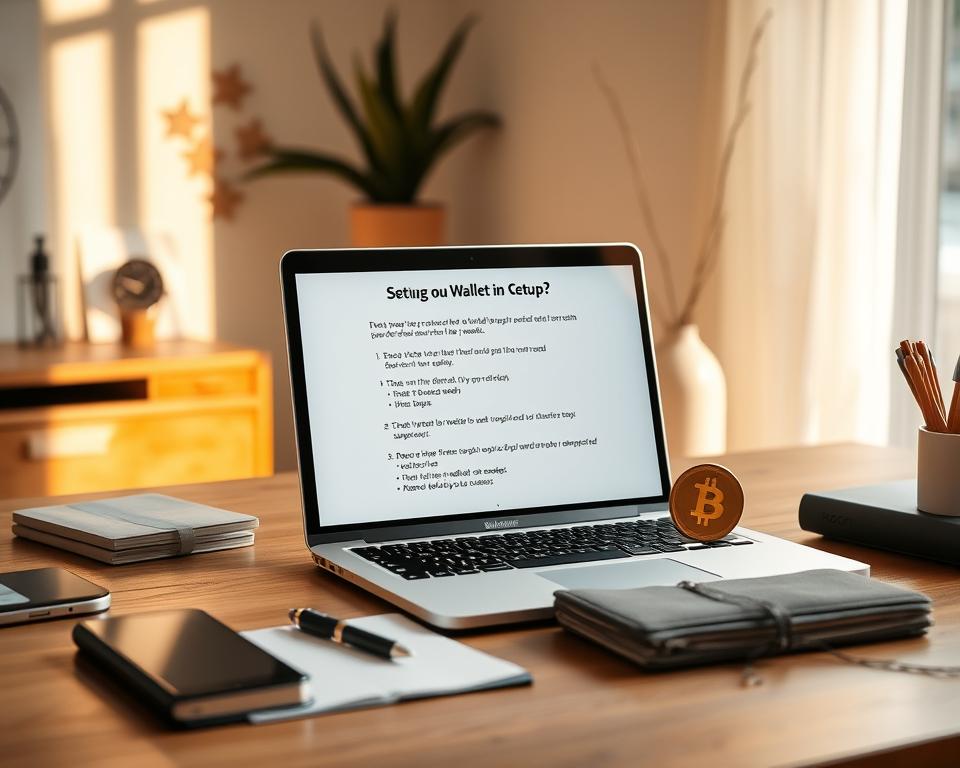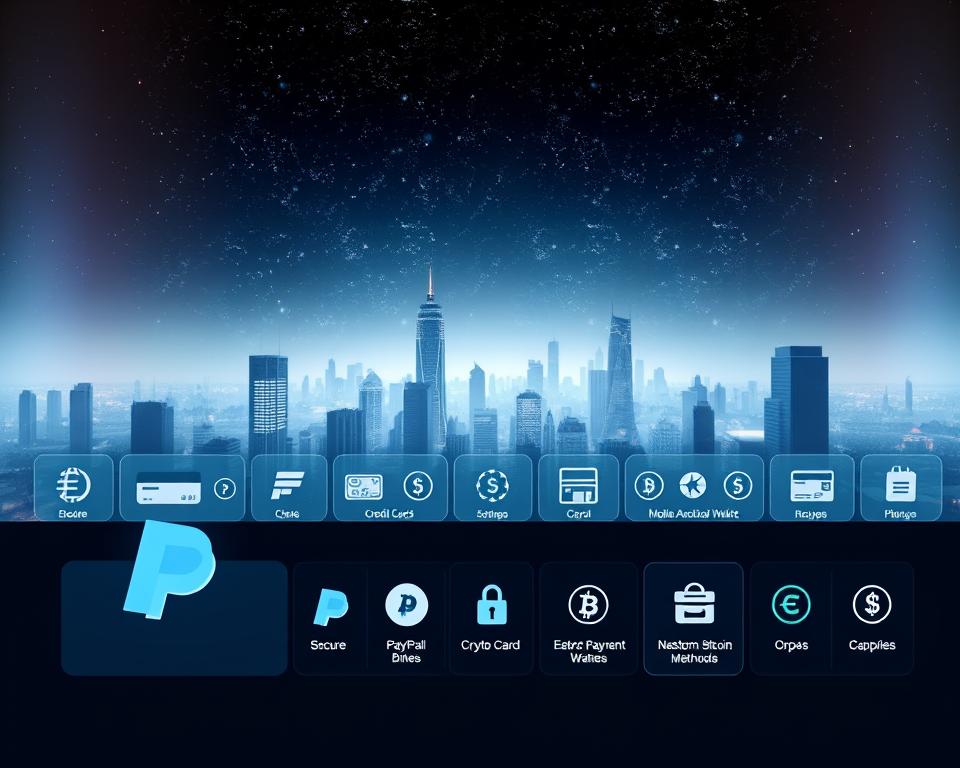
Bitcoin for Beginners: Setting Up Your First Wallet
Did you know there are over 300 million Bitcoin wallets worldwide as of 2023? This shows how big cryptocurrency has become. If you’re new to this world, learning how to get a bitcoin wallet is key. Setting up your first wallet is more than just tech; it’s about keeping your digital money safe.
In this article, we’ll cover the basics of creating a bitcoin wallet. We’ll make sure you know how to manage your cryptocurrency safely.
Key Takeaways
- Understanding the significance of a Bitcoin wallet.
- Different options available for bitcoin wallet creation.
- Key factors to consider when choosing a wallet.
- Best practices for securing your wallet.
- Steps for setting up your first Bitcoin wallet hassle-free.
Understanding Bitcoin and Its Importance
Bitcoin is a digital currency that has become very popular. It works without banks, making online payments safe. It uses a technology called blockchain to keep transactions open and secure.
Bitcoin is key in today’s money world. More people see it as a good choice instead of old money. It lets users send money worldwide, often cheaper than banks. Knowing about Bitcoin helps people make smart choices about money and the future of digital cash.

What is a Bitcoin Wallet?
A bitcoin wallet is a digital place to store and manage Bitcoin. It’s key for sending and getting Bitcoin. It holds your Bitcoin and the keys needed for transactions.
The public key is like your wallet’s address. The private key is your password, giving you access to your Bitcoin. It’s very important to keep your private key safe, as it controls your Bitcoin.
There are many types of bitcoin wallets, each with its own features. You should pick one that fits your needs for ease and safety. Wallets connect your digital assets to the Bitcoin network, making sure your transactions are safe.

Types of Bitcoin Wallets
Knowing about the different types of bitcoin wallets can make your crypto journey better. Each type has its own purpose and fits different user needs. The main difference is between hot wallets and cold wallets, which vary in how easy they are to use and how safe they are.
Hot Wallets vs. Cold Wallets
Hot wallets are always online and are great for quick transactions. They’re perfect for those who need fast access to their bitcoin. Examples include mobile apps and web-based wallets. But, they’re more at risk of hacking and cyber threats.
Cold wallets, however, are offline and are safer for long-term storage. They include physical devices like USB drives or dedicated hardware wallets. While they’re not as handy for daily use, they offer a safer option for those who value asset security.
Software Wallets and Hardware Wallets
It’s key to know the difference between software wallets and hardware wallets. Software wallets are apps for smartphones or computers. They’re easy to use and manage your bitcoin.
Hardware wallets, on the other hand, are physical devices for secure storage. They work offline, reducing the risk of online threats. They might cost more upfront, but many see it as a good investment for extra security.
How to Get a Bitcoin Wallet
Getting a bitcoin wallet is key for anyone new to cryptocurrency. First, pick a trustworthy wallet provider. Many people like Coinbase or Binance because they offer wallets and a place to buy and sell Bitcoin.
After choosing a provider, download an app or create an online account. You’ll need to share personal info and verify your identity. For extra security, consider a hardware wallet. These services focus only on wallets, giving you a better experience.
Here’s a table to help you decide:
| Wallet Type | Platform | Security Level | Ease of Use |
|---|---|---|---|
| Coinbase | Web / Mobile | High | Very Easy |
| Binance | Web / Mobile | High | Easy |
| Trezor | Hardware | Very High | Moderately Easy |
| Ledger | Hardware | Very High | Moderately Easy |
In short, getting a digital bitcoin wallet is easy with the right steps. Whether you use an exchange or a dedicated service, think about what you need. This will help you pick the best wallet for your cryptocurrency journey.
Choosing the Right Bitcoin Wallet for You
Choosing the right bitcoin wallet is key to managing your cryptocurrency well. You need to think about convenience, security, and fees. Knowing what you need helps make a choice that fits your lifestyle and how you use it.
Factors to Consider When Choosing
- Security: Wallets have different security levels, like two-factor authentication and encryption.
- Convenience: Check how easy it is to use your wallet for transactions.
- Fees: Different wallets charge different fees. Knowing this can prevent surprise costs.
Popular Bitcoin Wallet Options
| Wallet Name | Type | Key Features | Pros | Cons |
|---|---|---|---|---|
| Coinbase | Web & Mobile | User-friendly interface, built-in exchange | Easy to set up, good security | Higher fees |
| Exodus | Desktop & Mobile | Multi-currency support, built-in exchange | Intuitive design, customer support | No two-factor authentication |
| Ledger | Hardware | High-level security, offline storage | Very secure, multiple currency support | Higher initial cost |
Steps to Set Up a Bitcoin Wallet
Setting up a bitcoin wallet is a key step for anyone into cryptocurrency. It starts with installing a wallet app. This lets you manage your digital assets on your phone or computer. Here are the easy steps to get started.
Downloading a Wallet App
First, pick a reliable wallet app that fits your needs. Coinbase, Exodus, and Mycelium are popular choices. Each has its own features, so think about what you need before you download. Here’s how to install a wallet app:
- Go to your device’s app store (Google Play Store or Apple App Store).
- Search for the wallet app you want.
- Tap the download button and wait for it to finish.
Create Your New Wallet
After installing the app, create your bitcoin wallet. Open the app and follow the instructions. You’ll go through a few steps:
- Read and agree to the terms and conditions.
- Choose a strong password for your wallet.
- Get a recovery phrase. Keep this safe, as it’s key to getting back into your wallet if you forget your password.
By following these steps, you’ll set up a secure wallet for managing your digital currency.
| Feature | Coinbase | Exodus | Mycelium |
|---|---|---|---|
| User Interface | Beginner-friendly | Intuitive design | Advanced users |
| Supported Coins | Multiple cryptocurrencies | Bitcoin and others | Primarily Bitcoin |
| Backup Options | Cloud backup | Wallet backups | Paper backup |
Secure Bitcoin Wallet Setup Best Practices
Setting up a secure bitcoin wallet is key to protecting your assets. A strong password is the first defense against hackers. It should be unique and complex. Use a mix of letters, numbers, and symbols for the best protection.
Importance of Strong Passwords
Strong passwords are long and unique to avoid guessing. Don’t use common words or personal info. Try making passphrases from random words for strength and ease of remembering.
Change your passwords often. This way, even if one gets compromised, your wallet stays safe.
Two-Factor Authentication (2FA)
Two-factor authentication adds an extra layer of security. It asks for a second verification, like a code to your phone. This makes it harder for hackers to get into your wallet.
Many wallet providers offer 2FA. Turning it on is a must for keeping your wallet safe.
Creating a Cryptocurrency Wallet in a Few Simple Steps
Creating a cryptocurrency wallet might seem hard, but it’s easy with a simple guide. First, decide what kind of wallet you need. You can choose from hot wallets for daily use or cold wallets for safe storage.
Then, download the right wallet app for your choice. Look for trusted developers to keep your wallet safe. After installing, open the app and follow the setup steps.
Creating a strong password is key to wallet security. This step is very important. Most wallets also give you a recovery seed phrase. Keep this phrase safe, as losing it can mean losing your money.
Once you’ve done these steps, you’re ready to start with cryptocurrency. Use your wallet right away to get to know it. Explore the exciting world of digital money!
Obtaining a Digital Wallet for Bitcoin
Getting a digital wallet for bitcoin is key to managing your crypto. Knowing where to find wallets can make your experience better and safer. Many platforms offer wallet solutions, so it’s important to compare them before choosing.
Where to Obtain Bitcoin Wallets
There are many places to find bitcoin wallets. Here are some well-known ones:
- Cryptocurrency Exchanges: Sites like Binance and Coinbase have built-in wallets. They are easy to use and good for quick trades. But, using an exchange for storing funds can be risky, like getting hacked.
- Dedicated Wallet Providers: Sites like Blockchain.com offer separate wallets that focus on safety and control. They’re great for keeping your coins safe long-term but might be tricky for newbies.
- Wallet Apps: Mobile apps like Trust Wallet and Mycelium are handy for daily use. They’re easy to access but need you to keep your device secure.
Think about what you need when picking a digital wallet for bitcoin. Do your homework and look at features, security, and what other users say to choose wisely.
Steps to Acquire a Bitcoin Wallet
Getting a Bitcoin wallet is easy. First, pick the right type for you, thinking about safety and how easy it is to use. Start by choosing a trusted place like Coinbase or Binance to sign up and get your wallet.
Then, look for a wallet app that works on your device. There are many for phones and computers. Before downloading, check out reviews and the provider’s background to make sure it’s safe. Once you’ve picked the right app, install it and follow the setup steps.
Don’t forget to turn on extra security like two-factor authentication. These steps to acquire a bitcoin wallet help you start your crypto journey. They also help you manage your digital money wisely.
Backing Up Your Bitcoin Wallet
Backing up your bitcoin wallet is key to keeping your crypto safe. Things like device failure or accidental deletions can wipe out your funds. Knowing how important wallet backup is helps avoid risks. Having a backup plan means you can get your wallet back when you need it.
Importance of Backup
Not backing up your wallet puts your money at risk. A good backup plan includes several steps, like:
- Writing down recovery phrases on paper and keeping them safe.
- Using cloud storage for encrypted wallet copies.
- Making multiple backups to protect against loss or damage.
These steps show why wallet backup is so crucial. With a solid backup plan, you can always get to your bitcoin, even in tough times.
| Backup Method | Benefits | Risks |
|---|---|---|
| Writing Recovery Phrases | Simplicity and low cost | Physical loss or damage |
| Cloud Storage | Remote access from any location | Potential hacking threats |
| Multiple Backups | Redundancy protects against various failures | Increased management complexity |
Checking your backup plan often can boost your security a lot. Making backing up your bitcoin wallet a priority is vital for keeping your investment safe.
How to Open a Bitcoin Wallet Account
Opening a Bitcoin wallet account is a key step for anyone into cryptocurrency. First, pick a trustworthy wallet provider. Look into options like Coinbase, Binance, and Blockchain.com. They are known for being easy to use and secure.
Then, go to the wallet provider’s website or download their app. You’ll need to enter your personal info, like your name and email. Make sure your password is strong, with letters, numbers, and symbols.
After you enter your details, you’ll need to verify your identity. This might mean uploading your ID and confirming your phone or email. This step makes your wallet safer and follows the rules.
After verifying your identity, you can start using your wallet. Learn how to use the dashboard to manage your Bitcoin. Don’t forget to add extra security, like two-factor authentication, to keep your account safe.
| Step | Description |
|---|---|
| Select a Wallet Provider | Research options such as Coinbase or Binance. |
| Create Account | Fill out personal information and set a strong password. |
| Identity Verification | Upload ID and confirm your phone or email to verify your identity. |
| Set Up Wallet | Access your dashboard and manage your Bitcoin assets. |
| Enhance Security | Enable two-factor authentication for added protection. |
Keeping Your Bitcoin Wallet Secure
In the fast-changing world of cryptocurrency, keeping your bitcoin wallet safe is key. Many security risks can harm your digital assets, like phishing scams, malware, and hacking. Knowing about these risks and taking steps to protect your wallet can make a big difference.
Common Security Risks
First, it’s important to know the threats to your cryptocurrencies. Here are some common ones:
- Phishing Scams: Fake emails or websites that look real but steal your login info.
- Malware: Bad software that can harm your device and steal your data.
- Unsecured Wi-Fi Networks: Public or unsecured networks can let others access your wallet.
- Weak Passwords: Simple passwords can be guessed easily, letting others in.
Best Security Practices
To keep your bitcoin wallet safe, follow these best practices:
- Use strong, unique passwords for your wallet.
- Turn on two-factor authentication (2FA) if you can.
- Keep your wallet software up to date to fix security issues.
- Don’t use public Wi-Fi to access your wallet; use a private connection instead.
- Backup your wallet often and keep the backup in a safe place.
By knowing the common security risks and following the best practices, you can greatly improve your wallet’s safety. This way, your bitcoin wallet will be protected from many threats.
Managing Your Bitcoin Wallet Effectively
Managing your bitcoin wallet well means knowing key parts that shape your crypto journey. It’s important to understand transaction fees, as they can change the cost of your trades. Keeping an eye on your bitcoin can help you adjust your plans based on market changes and your financial goals.
Transaction Fees and Their Impact
Transaction fees in Bitcoin change based on how busy the network is and how fast you need your transactions. Knowing these fees is key to managing your wallet. Higher fees mean faster transactions, but lower fees might cause delays. It’s smart to think about what you need to balance cost and speed.
How to Monitor Your Holdings
Keeping an eye on your bitcoin means watching how your investments do and spotting trends. There are many tools and apps that help with this, giving you insights into prices and how your portfolio is doing. Being active with your wallet lets you make smart choices based on detailed tracking and analysis.
| Monitoring Tool | Features | Pros | Cons |
|---|---|---|---|
| Blockfolio | Portfolio tracking, alerts | User-friendly interface | Limited exchange support |
| CoinMarketCap | Market data, portfolio tracking | Extensive coin coverage | Less focus on wallet management |
| CryptoCompare | Real-time data, detailed analysis | Custom reporting | Complexity for beginners |
Conclusion
Understanding a bitcoin wallet is key for anyone starting with cryptocurrency. We’ve covered the different types of wallets, how to set them up, and keeping them safe. This summary reminds us that the right wallet is essential for secure transactions.
As we conclude, knowledge is indeed power. By learning how to manage your wallet, you’re ready to explore the world of cryptocurrency. Remember, a secure wallet comes from making informed choices and responsible management.
Whether you’re new or need a refresher, taking action now is important. It lets you join the Bitcoin world safely and enjoyably. Let your bitcoin wallet journey be a rewarding one.
FAQ
How do I get a Bitcoin wallet?
To get a Bitcoin wallet, first pick a trusted provider or platform. You can find one on exchanges like Coinbase, wallet services like Blockchain.com, or apps like Exodus. Just create an account and you’re all set!
What are the steps to set up a Bitcoin wallet?
Setting up a Bitcoin wallet means choosing a type, downloading the app, and creating a new wallet. Don’t forget to store your recovery phrases safely. Also, turn on 2FA for extra security.
What is the difference between hot wallets and cold wallets?
Hot wallets are online and easy for daily use. Cold wallets are offline for better security. Choose based on your needs.
How can I create a cryptocurrency wallet?
Create a wallet by picking a provider, downloading the app, and following the setup. Always back up your info and know your wallet’s features before using it.
What should I consider when choosing a Bitcoin wallet?
Look at convenience, security, fees, and supported currencies. Compare Ledger for hardware or Coinbase for software wallets to find the best for you.
How do I know if my Bitcoin wallet is secure?
A secure wallet uses strong encryption, offers 2FA, and asks for a strong password. Check the provider’s reputation and read reviews for safety.
What are some common security risks for Bitcoin wallets?
Risks include phishing, malware, and hacking. Stay safe by updating software and using secure connections.
Can I back up my Bitcoin wallet?
Yes, backing up your wallet is key to avoid data loss. Write down recovery phrases and use cloud storage with encryption.
How do I open a Bitcoin wallet account?
Open an account by giving personal info, verifying your identity, and agreeing to terms. Then, you can start using your wallet!
How do I manage transaction fees when using my Bitcoin wallet?
Keep an eye on network fees and adjust them in your wallet. Some wallets even have fee estimators to help you send Bitcoin at the right time.







